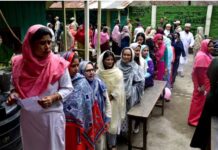
Hardly any improvement in workplace safety has taken place at the non-garment factories over the years as the authorities were primarily bogged down in fixing the loopholes in the apparel industry.
Such lax attitude on the part of the government allowed the breaches of rules to go on, triggering frequent industrial incidents and the death of innocent workers like the country witnessed on Thursday.
Although the industry people, the government and international communities said both the Tazreen Fashions Fire and the Rana Plaza building collapse, respectively in 2012 and 2013, were a wake-up call for Bangladesh, the safety concern was largely ignored in the workplaces at non-garment industries.
Despite the twin deadliest industrial incidents, the owners and the authorities did not take any lessons to improve the working conditions to save the lives of crores of workers employed in the non-RMG sectors.

The devastating fire incident on Thursday at Hashem Foods Ltd at Rupganj in Narayanganj is a glaring example of ignoring workplace safety measures. At least 52 workers died in the inferno at the juice processing plant.
Many survivors said the emergency evacuation routes were not easily accessible to move out of the upper floors, and the collapsible gates of various floors were locked. The ground floor was piled up with raw materials, which occupied the exit ways.
As a result, the workers were screaming in the thick and dark smoke before dying in the fire that continued throughout the night as it took time for the firefighters to douse it.
“Most of the focus was given to the improvement of workplace safety in the export-oriented garment industry. No visible initiative has been taken to improve workplace safety in the non-garment sectors,” said Khondaker Golam Moazzem, research director of the Centre for Policy Dialogue (CPD).
The safety inspections led by the Department of Inspection for Factories and Establishments (DIFE) mostly took place in garment factories to see if workers get salaries and other entitled benefits and they use child labour.
“We have seen fire incidents at chemical warehouses and plastic factories in old Dhaka. The rising incidences of the explosion of boilers and gas cylinders in garment and other sectors point to new areas of concern in the industrial sector. Overall, workplace safety in non-RMG sectors has not improved,” Moazzem said.
There is no proper monitoring of fire safety issues and compliance of building codes at the non-garment sectors, said Razequzzaman Ratan, president of Samajtantrik Sramik Front, a labour rights group.
“Hashem Foods also violated the labour law by hiring children and keeping the main gate locked.”
He said the garment sector, which accounts for 85 per cent of Bangladesh’s exports, received priority in the drive aimed at ensuring a safe workplace because of the pressure from buyers, brands, the European Union, and workers.
Wajedul Islam Khan, general secretary of the Bangladesh Trade Union Kendra, blamed the gross negligence and inefficiency of the DIFE for the fire incident at Rupganj.
He alleged that companies did not want elected labour unions, but the workers’ bodies could inform regulators about the mismanagement and help take necessary measures on the safety issue.
“Fatalities, incidents and illness at work can be prevented when employers, workers and governments respect international safety standards,” said Tuomo Poutiainen, country director of the International Labour Organisation.
Following the Tazreen Fire incident and Rana Plaza collapse, a collaborative initiative was taken by the government, employers and workers’ organisations, brands, and buyers to instil a safety culture in the garment sector, he said.
The focus was initially on the garment industry, with the understanding that the practices developed in the sector would be rolled out to other sectors over time.
“That has been happening over the past few years, but due to limited resources in the labour inspectorate and the coronavirus pandemic, the coverage in other sectors is not very extensive yet,” Poutiainen said.
“It is high time to speed up efforts to extend the good practices from the RMG sector to all other industries.”
Poutiainen said it was important to remember that industrial safety could not be truly achieved in a country without the presence of stronger regulation and accountability, workers’ voice and participation, and responsible practices by employers and building owners.
“We have been discussing the fire and safety issues for all the factories for the last many years, but no visible steps have been taken yet,” said Md Shakil Akhter Chowdhury, executive member of the Bangladesh Institute of Labour Studies.
After the Rana Plaza incident, some structural changes have been launched in the garment sector. “The non-garment industrial sector remains in bad shape for workers,” he said.
“Most of the resources and efforts were dedicated to improving the workplace safety in the garment sector, while other sectors have remained neglected,” said Syed Sultan Uddin Ahmmed, a former executive director of the BILS.
There are vast industrial sectors other than garments, but they receive less allocation and priority, he said.
Another reason for the recurrence of such incidents is the absence of punishment of owners and others, who were responsible for the death and injury of the workers, according to Ahmmed.
A culture of impunity has been established because of the delay in justice for the industrial killings, he said.
“As a result, owners remain uncaring. Besides, the reports of probe committees are not made public.”
Md Nasir Uddin Ahmed, inspector general of the DIFE, blamed the shortage of workforce in the government agency to properly oversee the safety issues in sectors other than the garment industry.
Currently, the number of approved posts for inspectors at the DIFE is more than 900. In reality, 400 employees are available, he said.
“We have requested the labour ministry to recruit 1,791 skilled employees for the DIFE.”
Two inspectors of the DIFE inspected the Hashem Foods building on July 7 and submitted a report, he said.
“Although the factory owners worked to resolve the labour rights issues to some extent, they did not address the safety issues,” the DIFE chief said.


 For all latest news, follow The Daily Star’s Google News channel.
For all latest news, follow The Daily Star’s Google News channel. 







